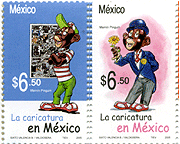MEMIN PINGUIN: not a platform on which to take a stand on racism

Imagine a 1950s type pre-adolescent boy, with red striped shirt, baseball cap (viser won in front) and old stylehigh top tennis shoes. He's sometimes naive, sometimes clever, always cute,and 100% boy. He is to Mexico what Dennis the Menace or Beaver Cleaverwas to the U.S. Now there is talk of making this retro comic strip figureinto a TV series or even a movie.
There's one complicating factor in this innocent nostalgia. Memin Pinguin is obviously of African Ancestry, and is portrayed stereotypically. Just last month, this beloved cartoon character was honored with a Mexican postage stamp.That was the spark (President Fox's comments about Mexicans doing work "even the Blacks won't do") was the accumulated dynamite leading to the explosion of rage from African American leaders who saw this as just another verification of Mexican racism.
The reaction among Mexicans is predictable:
1. "of all the things to get upset about"!
2. "you Gringos are the real racists"!
I agree with the Mexicans on the first point.What little I remember of Memin Pinguin is that this is pretty tame fare, and certainly nothing as overtly racist as the old radio program "Amos N Andy" or the 1970s TV program "Sanford and Son."
On the second point, I don't dare disagree with Mexicans south or north of the border. Just over this past year when I have had Spanish language mass in my Redlands home, some of the older attendees told me that when they were teenagers, the rule at the public swimming pool was segregated swimming. Mexican kids had to wait for their special day (the day before the pool was drained).
But there is another point which most Mexicans are not yet willing to address: the Mexican prejudice against blacks here in Mexico. After the Spanish conquest of the Aztec empire, over two hundred thousand African slaves were brought to Mexico, just as the Spanish, English, French, Dutch, Portuguese and Americans had done in other situations requiring tropical plantation agriculture. In Mexico, the African arrival was concentrated on the two coasts: around Veracruz in the gulf and around Acapulco's Costa Chica on the Pacific. Perhaps the best example of such a community is Cuajinicuilapa, Oaxaca, about four hours south of Acapulco. They have a museum worth a look: Museo de las Culturas Afromestizas.
Many of these Black Mexicans were among the first to fight in the independence movement of 1810 (and it is even rumored that some of the founding fathers of the Republic had some African ancestry). The new nation immediately abolished slavery, but then forgot about its third root of cultural heritage. Some of the black, isolated, rural and coastal villages in the states of Veracruz, Guerrero and Oaxaca were among the last to get electricity in the 1980s. Health care and educational facilities beyond primary grades are rare in these communities.If a student with African looks makes it to the university, the students and professors start off with the assumption of a foreign student from Africa or the Caribbean.
Here in Acapulco it is common to see persons of mixed African descent. You'll see them quite prominently as beach vendors, fishermen, sanitation and agricultural workers, somewhat less represented as hotel maid, and even less in high end retail establishments. They are so over-represented in stick shack "favela" squatter developments that these slums are often called "barrios negros."
It is against this background that we must viewMemin Pinguin. His looks may be stereotypical, but the behavioral stereotypes do not apply.In that sense, the revival of interest inMemin Pinguin may serve to bring about an acknowledgement of Mexicans of African descent,of their role as the "Tercer Raiz" of Mexican culture.

0 Comments:
Post a Comment
<< Home